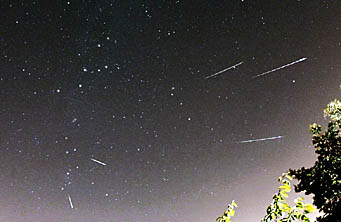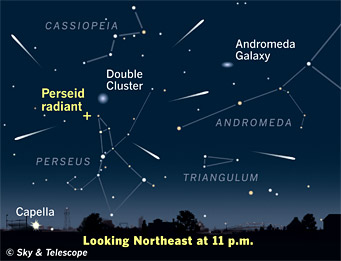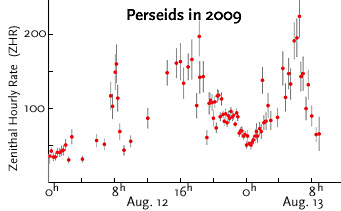well..i am looking forward to aug 12 and 13..for the persied meteor showers...
we used to pull the pick up out into the field with cots and critters and enjoy the whole night of shooting stars
very sadly the last couple of years it has been clouded over and no viewing possible
this year there are different canines and a fence so the bed of the pickup to save my toes from raccoon nibbles
won't be necessary... 
if you guys can stand to be out all night just watching the sky..do it..it is a treat
maybe a little fire, a beverage, a snack, comfy sleeping bag, binoculars. critters ..you know..star gazing at it's besthere is an article about it and a little reseach will get you more info...http://www.skyandtelescope.com/observing/home/99304684.htmlHOMEPAGE OBSERVING by Alan MacRobert
Dark Nights for the Perseids

Gain Lee recorded this montage of bright Perseids over a two-hour period in August 2007 from his heavily light-polluted backyard in Huddersfield, England. He took many short exposures with a 15-mm f/2.8 fisheye lens, then combined the lucky few frames that captured a meteor with one that included the foreground. Click here for a wider view, which shows Cassiopeia near center and the shower's radiant point below it in northern Perseus. The nonconformist meteor off by the Big Dipper at far left is a Kappa Cygnid.
Gain LeeThe last time the annual Perseid meteor shower happened during a run of good moonless nights was in 2007. It turns out that every three years, the same phase of the Moon returns to roughly the same date each month (2.2 days earlier, on average). So in 2010 we're on for moonless Perseids again!
The shower lasts for many days, but according to the International Meteor Organization this year's peak should occur during a half-day-long window centered on 1:00 Universal Time on August 13th, which is ideal timing for skywatchers in Eurasia. For North Americans, the best viewing will probably be late Thursday night and early Friday morning, August 12-13, or possibly the night before.
In any case, prime viewing for the Perseids is from about 11 p.m. or midnight (local time) until the first light of dawn. This is when the shower's radiant (its perspective point of origin) is well up in your sky. The higher the radiant, the more meteors you'll see.

The Perseid meteors appear to stream away from their radiant near the border of Perseus and Cassiopeia. And while you're outside on a dark night, don't forget to look for the Double Cluster and the Andromeda Galaxy, two of the easiest "faint fuzzies" to spot with your unaided eyes.
S&T Illustration
Many longtime skywatchers remember the fine displays the Perseids put on in the early 1990s, around when the shower's parent comet, 109P/Swift-Tuttle, last passed through the inner solar system. Those days are gone; the comet won't be back until 2126. But even now some, thin, dense filaments of meteoroids that the comet shed in recent centuries continue to liven up the shower's behavior. Strands left behind by the comet in 441 and 1479 might be in play this year, though only a little enhancement is expected from them.
At a very dark, rural site, you can probably expect to see 100 or more meteors per hour when the radiant (in northern Perseus) is highest in your sky before the first light of dawn. Any light pollution will cut down on the numbers, as will the radiant's lower altitude earlier in the night. But the brightest few meteors shine right through light pollution, and the few that happen when the radiant is low are especially long, skimming the upper atmosphere and flying far across the sky.
To get the most enjoyment while watching for Perseids, find a dark spot with an open sky view, bundle up thoroughly in blankets or a sleeping bag (for mosquito shielding as well as warmth, and don't forget the repellent), and lie back in a reclining chair. Gaze into the stars, and be patient. The best direction to watch is wherever your sky is darkest, usually straight up, perhaps with a little inclination toward the radiant. That's all there is to it!

In 2009 the Perseid shower displayed three separate, strong peaks during its most active 36 hours (shown in Universal Time), as revealed in this plot based on 8,158 Perseid sightings reported by 144 observers worldwide.
Geert Barentsen / IMOIf you're a little more ambitious, you can make a careful meteor count and report it to the International Meteor Organization. Such counts are analyzed to yield the shower's zenithal hourly rate, which is the number of meteors that a single observer would see per hour under ideal conditions: with the radiant directly overhead (at the zenith) and the sky dark enough to reveal 6.5-magnitude stars.
Not all the meteors you'll see are Perseids. In addition to occasional random, sporadic meteors, the weaker Delta Aquarid shower is also active during Perseid season. The Delta Aquarids are slower, often yellower, and track away from a radiant point in eastern Aquarius. Weaker still are the Kappa Cygnids, identifiable by their flight direction away from Cygnus in an altogether different part of the sky.
Don't forget that the Perseid shower lasts for more than one night! Rates are about a quarter to half the peak for one or two nights before and after. A few forerunners of the shower may show up as early as July 20th, and stragglers have been recorded as late as August 24th.
Posted by Alan MacRobert, July 27, 2010
related content: Celestial events
links: + digg | + del.icio.us | + reddit | + permalink | + rss
comments (2)
***********************************************************************
http://en.wikipedia.org/wiki/Perseids*************************************************************************
http://www.space.com/*****************************************************
http://www.spaceweather.com/ 
